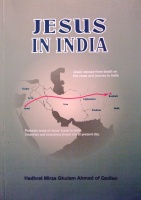Jesus in India (book)
This article has multiple issues. Please help improve it or discuss these issues on the talk page. (Learn how and when to remove these messages)
|

| Part of a series on
Ahmadiyya |
|---|
 |
Jesus in India (Urdu: Masīh Hindustān Meiń) is a treatise written by Mirza Ghulam Ahmad, the founder of the Ahmadiyya Movement. The treatise, which was then published as a book, discusses Jesus’ possible survival from crucifixion and his subsequent migration towards Kashmir in order to preach to the 'Lost Tribes of Israel'.[1][2] Ghulam Ahmad argues his case with reference to Christian as well as Muslim scriptures and medical and historical books including ancient Buddhist records, although the viewpoints are rejected in orthodox Muslim and Christian teachings. Jesus in India is often cited as original source material in literature that deals with the issue of Jesus’ putative post-crucifixion life. [3]
Background
The treatise was completed in 1899, was partly serialised in the Review of Religions (which he founded in 1902) until 1903; and was then published shortly after Ghulam Ahmad’s death in 1908.[1] The first complete English translation was published in 1944.[1]
Concepts of the book
The treatise suggests that Jesus, starting his journey from Jerusalem and passing through Nasibus and Persia, eventually reached Afghanistan where he met the Israelites who had settled there after their escape from the bonds of Nebuchadnezzar. From here he travelled to Kashmir where some Israelite tribes had also settled. Here he lived until his death at an old age.[4]
Ghulam Ahmad also differs herein from other individual’s views, who on account of the resemblance between Buddhistic and Christian teachings and between the life of Jesus and that of Buddha as recorded in their respective scriptures; held that Buddhistic teachings must somehow have reached Palestine and incorporated by Jesus, or that he must have travelled to India pre-crucifixion and returned to Palestine after having imbibed Buddhistic teachings. [5] As opposed to this Ghulam Ahmad asserts that Jesus came to India only after the crucifixion and it was not he who borrowed Buddha’s teachings but the Buddhists who seem to have reproduced elements of the Gospels in their scriptures. Ghulam Ahmad is able to support this view by arguing that Jesus also preached to the Buddhist monks some of whom were originally Jews, as asserted in this work. They having accepted him as the manifestation of the Buddha, the 'Promised Teacher' incorporated his teachings into those of Buddha’s.
Jesus in India also contains claims on the whereabouts of the Lost Tribes of Israel, suggesting that these tribes were scattered throughout Afghanistan, Kashmir, and Western China.[6] It also provides a list of tribes of these regions seeking to trace their Israelite roots.[dubious – discuss]
Chapters
The initial work was indented to comprise ten chapters but due to unforeseen circumstances and as stated by the Ahmadis, Ghulam Ahmad, having to attend to other important works, ended the book with four chapters:
Introduction
Chapter 1
- Evidence from the Gospels
Chapter 2
- Evidence from the Quran and Authentic traditions
Chapter 3
- Evidence derived from Medical Literature
- List of Books mentioning Marham-i-Isa (ointment of Jesus), and that the Ointment was Prepared for Jesus’ Wounds
Chapter 4
- Evidence from Historical Records
Section 1:
- Evidence from Islamic literature concerning Jesus’ journeys
- Probable Route Map of Jesus’ Journey to India
Section 2:
- Evidence from Buddhist Records
Section 3:
- Evidence from Historical Writings which Show that Jesus’ Journey to the Punjab and Neighbouring Territories was Inevitable
- List of 24 Tribes of Abdalees
Appendix
Alleged discovery
Ahmadiyya literature states that one of Ghulam Ahmad’s disciples, Khalifa Nur Din (or, Noor al-Din) of Jalalpur Jattan, District Gujrat, spoke to him about a tomb in Srinagar that was said to be the tomb of a prophet named Yuz Asaf. Ghulam Ahmad instructed him to do some further research into the matter. Nur Din went to Srinagar and stayed there for about four months. He collected information and also obtained the signatures of 556 inhabitants who attested that, according to their traditions, the remains of Jesus Christ lay in the Roza Bal.[7] He also brought back a sketch of the Roza Bal. Thereafter, Ghulam Ahmad decided to send one of his followers, Maulvi Abdullah, to Kashmir to investigate this tomb. Maulvi Abdullah arrived in Kashmir, conducted his investigations, and wrote back to Ghulam Ahmad about his findings. Ghulam Ahmad then published a poster that contained Maulvi Abdullah’s letter, as well as Maulvi Abdullah’s sketch of the Roza Bal.
Ghulam Ahmad began studying the local traditions of the people of Kashmir, both oral and written, and discovered that these traditions, as mentioned in the letter from Maulvi Abdullah, referred to the Roza Bal as the tomb of Nabi Isa (Prophet Jesus). According to this information, the Muslims in that locality did not believe Jesus to be in heaven, as was taught by the orthodox clergy. The Ahmadiyya publication, Review of Religions, recorded this belief in its October, 1909 edition.[8]
See also
- Jesus in Ahmadiyya Islam
- The Ten Lost Tribes
- Turin Shroud
- The Jesus Conspiracy
- Writings of Mirza Ghulam Ahmad
References
- ^ a b c The publisher's note (page v) at the beginning of the book states: "Written in 1899, and partly serialized in Review of Religions in 1902 and 1903, the book itself was posthumously published on 20th November 1908." Jesus in India by Mirza Ghulam Ahmad (1 July 2003) ISBN 1853727237
- ^ J. Gordon Melton The Encyclopedia of Religious Phenomena 2007 p377
- ^ http://www.tombofjesus.com/2007/core/founders/ahmad/index.html
- ^ http://www.alislam.org/library/books/jesus-in-india/preface.html
- ^ http://www.tombofjesus.com/2007/core/founders/notovitch/index.html
- ^ http://www.alislam.org/sunrise/sunrise2003-4.pdf
- ^ http://www.tombofjesus.com/2007/core/founders/ahmad/index.html
- ^ http://www.tombofjesus.com/2007/core/founders/ahmad/Letter_of_Maulvi_Abdullah.pdf
